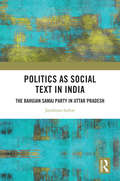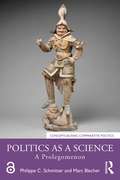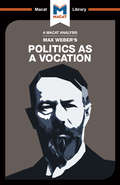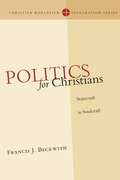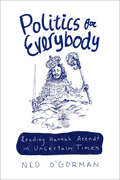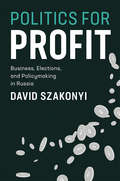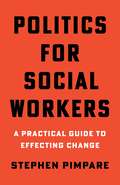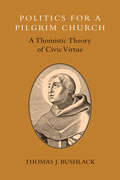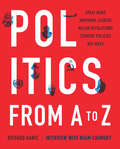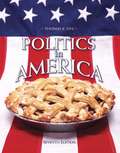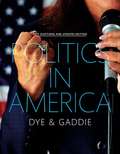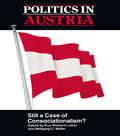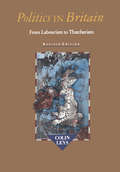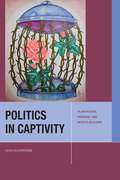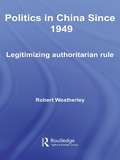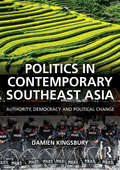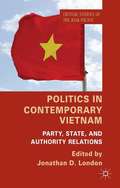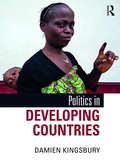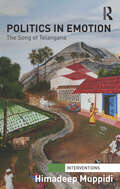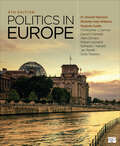- Table View
- List View
Politics as Social Text in India: The Bahujan Samaj Party in Uttar Pradesh
by Jayabrata SarkarThis book explores the emergence of the Bahujan Samaj Party (BSP) as an alternative political force in Uttar Pradesh. It focuses on the historical continuity of Dalit social justice movements and organizational politics from pre- to post-colonial India and its subsequent institutionalization as a political force with the rise of the BSP in the state since the 1980s. The volume discusses the new age Dalit–Bahujan politics and its ethnicization of caste groups to create a bahujan samaj. The book analyzes the focused political leadership of Kanshiram and Mayawati, the strong party organization, and how they evolved an empowered Dalit ideology and identity by grassroots mobilization and championing Dalit icons and history. The author also explores the party’s strategies, slogans and alliances with other political parties and communities and its political manoeuvrings to retain its influence over the electorate. The book also effectively identifies the reasons for the political marginalization of the BSP in present times in the context of the phenomenal rise of the BJP in the state. The book will be of great interest to researchers and scholars of political science, sociology, Dalit and subaltern studies, exclusion studies and those working on the intersectionality of caste and class. It will also be useful for policy makers, think tanks and NGOs working in the domain of caste, marginality, social exclusion and identity politics.
Politics as a Science: A Prolegomenon (Conceptualising Comparative Politics)
by Philippe C. Schmitter Marc BlecherIn Politics as a Science, two of the world's leading authorities on Comparative Politics, Philippe C. Schmitter and Marc Blecher, provide a lively introduction to the concepts and framework to study and analyze politics. Written with dexterity, concision and clarity, this short text makes no claim to being scientific. It contains no disprovable hypotheses, no original collection of evidence and no search for patterns of association. Instead, Schmitter and Blecher keep the text broadly conceptual and theoretical to convey their vision of the sprawling subject of politics. They map the process in which researchers try to specify the goal of the trip, some of the landmarks likely to be encountered en route and the boundaries that will circumscribe the effort. Examples, implications and elaborations are included in footnotes throughout the book. Politics as a Science is an ideal introduction for anyone interested in, or studying, comparative politics. “The Open Access version of this book, available at http://www.taylorfrancis.com/doi/view/10.4324/9781003032144, has been made available under a Creative Commons Attribution-Non Commercial-No Derivatives 4.0 license.”
Politics as a Vocation
by Jason Xidias William Brett Tom McCleanGerman sociologist Max Weber’s 1919 lecture Politics as a Vocation is widely regarded as a masterpiece of political theory and sociology. Its central strength lies in Weber’s deployment of masterful interpretative skills to power his discussion of modern politics. Interpretation involves understanding both the meaning of evidence and the meaning of terms – questioning definitions, clarifying terms and processes, and supplying good, clear definitions of the author’s own. As a sociologist accustomed to working with historical evidence, Weber based his own work on precisely these skills, solidly backed up by analytical acuity. Politics as a Vocation, written in a Germany shocked by its crippling defeat in World War I, saw Weber turn his eye to an examination of how the modern nation state emerged, and the different ways in which it can be run – interpreting and defining the different types of rule that are possible. It is testament to Weber’s interpretative skills that Politics is famous above all in sociological circles for its clear definition of a state as an institution that claims “the monopoly of legitimate physical violence” in a given territory.
Politics at Work: How Companies Turn Their Workers into Lobbyists
by Alexander Hertel-FernandezAmerican employers are increasingly recruiting their workers into politics to change elections and public policy--sometimes in coercive ways. Using a diverse array of evidence, including national surveys of workers and employers, as well as in-depth interviews with top corporate managers, Alexander Hertel-Fernandez's Politics at Work explains why mobilizing workers has become an appealing corporate political strategy in recent decades, and assesses the effect of employer mobilization on the political process more broadly, including its consequences for electoral contests, policy debates, and political representation. Hertel-Fernandez shows that while employer political recruitment has some benefits for American democracy--for instance, getting more workers to the polls--it also has troubling implications for our democratic system. Workers face considerable pressure to adhere to their managers' political requests because of the economic power employers possess over workers. In spite of these worrisome patterns, Hertel-Fernandez found that corporate managers view the mobilization of their own workers as an important strategy for influencing politics. As he shows, companies consider mobilization of their workers to be even more effective at advancing policy change than making campaign contributions or buying electoral ads. By carefully examining a growing yet underappreciated political practice, Politics at Work reveals the novel methods corporations have employed in recent years to increase their power over the American political process. It is essential reading for anyone interested in the connections between inequality, public policy, and American democracy. Alexander Hertel-Fernandez is Assistant Professor of International and Public Affairs at Columbia University. His research has appeared in the American Prospect, the New York Times, the New Yorker, the Washington Post, and Democracy Journal, as well as numerous scholarly journals.
Politics for Christians: Statecraft as Soulcraft
by Francis J. BeckwithPolitics is concerned with citizenship and the administration of justice--how communities are formed and governed. The role of Christians in the political process is hotly contested, but as citizens, Francis Beckwith argues, Christians have a rich heritage of sophisticated thought, as well as a genuine responsibility, to contribute to the shaping of public policy. <P><P>In particular, Beckwith addresses the contention that Christians, or indeed religious citizens of any faith, should set aside their beliefs before they enter the public square. What role should religious citizens take in a liberal democracy? What is the proper separation of church and state? What place should be made for natural rights and the moral law within a secular state? This cogent introduction to political thought surveys political science, politics and government while making the case for how statecraft may genuinely contribute to soulcraft. Politics for Christians is part of The Christian Worldview Integration Series.
Politics for Everybody: Reading Hannah Arendt in Uncertain Times
by Ned O'GormanRediscover what politics actually is and what miracles it can achieve—once it’s separated from partisanship, polarization, and pointless yelling.In this age of nearly unprecedented partisan rancor, you’d be forgiven for thinking we could all do with a smaller daily dose of politics. In his provocative and sharp book, however, Ned O’Gorman argues just the opposite: Politics for Everybody contends that what we really need to do is engage more deeply with politics, rather than chuck the whole thing out the window.In calling for a purer, more humanistic relationship with politics—one that does justice to the virtues of open, honest exchange—O’Gorman draws on the work of Hannah Arendt. As a German-born Jewish thinker who fled the Nazis for the United States, Arendt set out to defend politics from its many detractors along several key lines: the challenge of separating genuine politics from distorted forms; the difficulty of appreciating politics for what it is; the problems of truth and judgment in politics; and the role of persuasion in politics. O’Gorman’s book offers an insightful introduction to Arendt’s ideas for anyone who wants to think more clearly and speak more carefully in a time when constructive political functioning is desperately needed.“Animated not just by a theoretical and academic interest in Arendt’s work, but also by a practical intent to change the current manner of seeing politics and improve the quality of citizenship and freedom, as well as the daily art of living together.” —The Review of Politics
Politics for Profit: Business, Elections, and Policymaking in Russia (Cambridge Studies in Comparative Politics)
by David SzakonyiBusinesspeople run for and win elected office around the world, with roughly one-third of members of parliament and numerous heads of states coming directly from the private sector. Yet we know little about why these politicians choose to leave the private sector and what they actually do while in government. In Politics for Profit, David Szakonyi brings to bear sweeping quantitative and qualitative evidence from Putin-era Russia to shed light on why businesspeople contest elections and what the consequences are for their firms and for society when they win. The book develops an original theory of businessperson candidacy as a type of corporate political activity undertaken in response to both economic competition and weak political parties. Szakonyi's evidence then shows that businesspeople help their firms reap huge gains in revenue and profitability while prioritizing investments in public infrastructure over human capital. The book finally evaluates policies for combatting political corruption.
Politics for Social Workers: A Practical Guide to Effecting Change
by Stephen PimpareThe social work profession calls on its members to strive for social justice. It asks aspiring and practicing social workers to advocate for political change and take part in political action on behalf of marginalized people and groups. Yet this macro goal is often left on the back burner as the day-to-day struggles of working directly with clients take precedence. And while most social workers have firsthand knowledge of how public policy neglects or outright harms society’s most vulnerable, too few have training in the political processes that created these policies.This book is a concise, accessible guide to help social workers understand how politics and policy making really work—and what they can do to help their clients and their communities. Helping readers develop sustainable strategies at the micro-, meso-, and macro-levels, this book is a hands-on manual to contemporary American politics, showing social workers and social work students how to engage in effective activism. Stephen Pimpare, a political scientist with extensive experience as a social work practitioner and instructor, offers informed, practical grounding in the mechanics of policy making and the tools that activists and outsiders can use to take on an entrenched system. He distills key research and insights from political science and related disciplines into a practical resource for social work students, instructors, and practitioners looking to deepen their policy knowledge and capacity to achieve change.
Politics for a Pilgrim Church: A Thomistic Theory of Civic Virtue
by Thomas J. BushlackPresents an innovative, constructive alternative to Christian involvement in the "culture wars" Church leaders and scholars have long wrestled with what should provide a guiding vision for Christian engagement in culture and politics. In this book Thomas Bushlack argues that a retrieval of Thomas Aquinas's understanding of civic virtue provides important resources for guiding this engagement today. Bushlack suggests that Aquinas's vision of the pilgrim church provides a fitting model for seeking the earthly common good of the political community, and he notes the features of a Thomistic account of justice and civic virtue that remain particularly salient for the twenty-first century. The book concludes with suggestions for cultivating a Christian rhetoric of the common good as an alternative to the predominant forms of discourse fostered within the culture wars that have been so divisive.
Politics for a Pilgrim Church: A Thomistic Theory of Civic Virtue
by Thomas J. BushlackPresents an innovative, constructive alternative to Christian involvement in the "culture wars" Church leaders and scholars have long wrestled with what should provide a guiding vision for Christian engagement in culture and politics. In this book Thomas Bushlack argues that a retrieval of Thomas Aquinas's understanding of civic virtue provides important resources for guiding this engagement today. Bushlack suggests that Aquinas's vision of the pilgrim church provides a fitting model for seeking the earthly common good of the political community, and he notes the features of a Thomistic account of justice and civic virtue that remain particularly salient for the twenty-first century. The book concludes with suggestions for cultivating a Christian rhetoric of the common good as an alternative to the predominant forms of discourse fostered within the culture wars that have been so divisive.
Politics for the Love of Fandom: Fan-Based Citizenship in a Digital World
by Ashley HinckPolitics for the Love of Fandom examines what Ashley Hinck calls “fan-based citizenship”: civic action that blends with and arises from participation in fandom and commitment to a fan-object. Examining cases like Harry Potter fans fighting for fair trade, YouTube fans donating money to charity, and football fans volunteering to mentor local youth, Hinck argues that fan-based citizenship has created new civic practices wherein popular culture may play as large a role in generating social action as traditional political institutions such as the Democratic Party or the Catholic Church. In an increasingly digital world, individuals can easily move among many institutions and groups. They can choose from more people and organizations than ever to inspire their civic actions—even the fandom for children's book series Harry Potter can become a foundation for involvement in political life and social activism. Hinck explores this new kind of engagement and its implications for politics and citizenships, through case studies that encompass fandoms for sports, YouTube channels, movies, and even toys. She considers the ways in which fan-based social engagement arises organically, from fan communities seeking to change their world as a group, as well as the methods creators use to leverage their fans to take social action. The modern shift to networked, fluid communities, Hinck argues, opens up opportunities for public participation that occurs outside of political parties, houses of worship, and organizations for social action. Fan-based citizenship performances help us understand the future possibilities of public engagement, as fans and creators alike tie the ethical frameworks of fan-objects to desired social goal, such as volunteering for political candidates, mentoring at-risk youth, and promoting environmentally friendly policy. Politics for the Love of Fandom examines the communication at the center of these civic actions, exploring how fans, nonprofits, and media companies manage to connect internet-based fandom with public issues.
Politics from A to Z
by Richard GanisDeepen your understanding of how politics work, and why they matter, with this timely guide. Politics from A to Z provides an up-to-date, thoroughly researched glossary of political topics spanning ancient Greece to contemporary America. Featuring an introductory interview with Noam Chomsky, Politics from A to Z is ideal for anyone interested in politics, from beginners to scholars. With detailed entries, visual references, and useful timelines, Politics from A to Z introduces the influential figures and ideas that have shaped politics, from the American Revolution to Zionism.
Politics in America (7th Edition)
by Thomas R. DyeA lively and absorbing text exploring the struggle for power among the participants, the stakes involved, the processes adopted, and the institutions affected.
Politics in America: 2014 Elections and Updates Edition
by Thomas R. Dye Ronald Keith GaddiePolitics in America introduces students to the political struggles that drive democracy, examining the participants, the stakes, the processes, and the institutional arenas that comprise the power game of American politics. Using Harold Lasswell’s classic definition of politics – “who gets what, when, and how” – as their unifying framework, authors Thomas Dye and Ronald Keith Gaddie present balanced arguments on highly sensitive issues including abortion, gun control, same-sex marriage, marijuana decriminalization, and immigration reform. In order to boost student engagement, the 2014 Elections and Updates Edition incorporates coverage of contemporary issues that dominate today’s headlines, as well as the most up-to-date data.
Politics in Austria: Still a Case of Consociationalism
by Wolfgang C. Müller Kurt Richard LutherFirst Published in 1992. Routledge is an imprint of Taylor & Francis, an informa company.
Politics in Britain
by Colin LeysControversial when the first edition was published in 1983, Colin Leys' analysis of the changing face of British politics has been confirmed by events of the late 1980s. The second edition, revised throughout, is brought up to date with substantial new material on the Thatcher era.Leys provides a solid body of information on the central topics of British politics--not only the nature of political parties or the evolution of the State, but also the organization of capital and labour, corporatism, the transformations of local democracy, the sphere of law and order, and other areas seldom discussed in more orthodox texts.The book also includes new accounts of Thatcher's program of de-nationalization and of the changes to the Welfare State. Now more relevant than ever, Politics in Britain has yet to be surpassed as an introduction to its subject.
Politics in Captivity: Plantations, Prisons, and World-Building (Just Ideas)
by Lena ZuckerwiseFrom the 1811 German Coast Slave Rebellion to the 1971 Attica Prison Uprising, from the truancy of enslaved women to the extreme self-discipline exercised by prisoners in solitary confinement, Black Americans have, through time, resisted racial regimes in extraordinary and everyday ways. Though these acts of large and small-scale resistance to slavery and incarceration are radical and transformative, they have often gone unnoticed. This book is about Black rebellion in captivity and the ways that many of the conventional well-worn constructs of academic political theory render its political dimensions obscure and indiscernible. While Hannah Arendt is an unlikely theorist to figure prominently in any discussion of Black politics, her concepts of world and worldlessness offer an indispensable framework for articulating a theory of resistance to chattel and carceral captivity. Politics in Captivity begins by taking seriously the ways in which slavery and incarceration share important commonalities, including historical continuity. In Zuckerwise’s account of this commonality, the point of connection between enslaved and incarcerated people is not exploited labor, but rather resistance. The relations between the rebellions of both groups appear in the writings of Muhammed Ahmad, Angela Davis, George Jackson, Ruchell Magee, and Assata Shakur, a genre Zuckerwise calls Black carceral political thought. The insights of these thinkers and activists figure into Zuckerwise’s analyses of largescale uprisings and quotidian practices of resistance, which she conceives as acts of world-building, against conditions of forced worldlessness. In a moment when a collective racial reckoning is underway; when Critical Race Theory is a target of the Right; when prison abolition has become more prominent in mainstream political discourse, it is now more important than ever to look to historical and contemporary practices of resistance to white domination.
Politics in China since 1949: Legitimizing Authoritarian Rule (Routledge Contemporary China Series #Vol. 11)
by Robert WeatherleySince the victory of the 1949 revolution the incumbency of the Chinese Communist Party has been characterized by an almost relentless struggle to legitimize its monopoly on political power. During the Mao era, attempts to derive legitimacy focused primarily on mass participation in political affairs, a blend of Marxist and nationalist ideology, and the charismatic authority of Mao Zedong. The dramatic failure of the Cultural Revolution forced the post-Mao leadership to discard these discredited paradigms of legitimacy and move towards an almost exclusively performance based concept founded on market economic reform. The reforms during the 1980s generated a number of unwelcome but inevitable side effects such as official corruption, high unemployment and significant socio-economic inequality. These factors culminated ultimately in the 1989 demonstrations in Tiananmen Square and throughout China. Since Tiananmen the party has sought to diversify the basis of its legitimacy by adhering more closely to constitutional procedures in decision making and, to a certain extent, by reinventing itself as a conservative nationalist party. This probing study of post-communist revolution Chinese politics sets out to discover if there is a plausible alternative to the electoral mode or if legitimacy is the exclusive domain of the multi-party system.
Politics in Commercial Society
by Michael Sonenscher Istvan Hont Béla KapossyScholars normally emphasize the contrast between the two great eighteenth-century thinkers Jean-Jacques Rousseau and Adam Smith. Rousseau is seen as a critic of modernity, Smith as an apologist. Istvan Hont, however, finds significant commonalities in their work, arguing that both were theorists of commercial society and from surprisingly similar perspectives.<P><P> In making his case, Hont begins with the concept of commercial society and explains why that concept has much in common with what the German philosopher Immanuel Kant called unsocial sociability. This is why many earlier scholars used to refer to an Adam Smith Problem and, in a somewhat different way, to a Jean-Jacques Rousseau Problem. The two problems―and the questions about the relationship between individualism and altruism that they raised―were, in fact, more similar than has usually been thought because both arose from the more fundamental problems generated by thinking about morality and politics in a commercial society.<P> Commerce entails reciprocity, but a commercial society also entails involuntary social interdependence, relentless economic competition, and intermittent interstate rivalry. This was the world to which Rousseau and Smith belonged, and Politics in Commercial Society is an account of how they thought about it.
Politics in Contemporary Southeast Asia: Authority, Democracy and Political Change
by Damien KingsburyThe countries of Southeast Asia continue to change, evolve and chart courses that sometimes leave outside observers puzzled. Politics in Contemporary Southeast Asia thoroughly assesses the political challenges and changes faced by the countries of Southeast Asia in the 21st century. Focusing on political processes throughout, Kingsbury introduces readers to the challenges of representation and accountability of the regional governments, degrees of good governance and transparency, and the role of elites and militaries in shaping or determining political outcomes. This book provides: A comprehensive, but accessible, introduction to political change and processes in Southeast Asia. Analytic criteria for assessment of case studies. Detailed country-specific surveys. Information based on extensive research on, and work in, the region. Providing cutting-edge coverage of South Asian politics in all regions, this highly accessible and comprehensive book is suitable for undergraduate and postgraduate courses on South East Asian Studies, Asian Politics, and Democratization.
Politics in Contemporary Vietnam
by Jonathan D. LondonVietnam's political development has entered an extraordinary, if indeterminate, phase. Comprising contributions from leading Vietnam scholars, this volume comprehensively explores the core aspects of Vietnam's politics, providing a cutting-edge analysis of politics in one of East Asia's least understood countries.
Politics in Developing Countries
by Damien KingsburyPolitics in Developing Countries provides a clear and reader-friendly introduction to the key factors and themes that shape political processes in developing countries. Achieving development outcomes such as reducing poverty and inequality is only possible through efficient governance, well-planned policies and careful allocation of resources, but often politics in developing countries has been identified with mismanagement, corruption, conflict and repression of dissent. This book assesses the politics of developing countries in the period since decolonisation, focusing on the ways in which states have or have not worked to the advancement of their citizens’ interests. Key topics include: Colonialism and its legacy Ethnicity and nation building Governance, corruption and the role of the state Poverty and the political economy of development Aid and outside influence. Drawing on a range of case studies from around the world, Politics in Developing Countries looks at the consistencies and variations between developing countries, examining why some have forestalled political change by liberalising their economies, and others have actively stifled calls for change. Wide-ranging and engagingly written, this introductory textbook is perfect for students of politics and international development, as well as for those with a general interest in the challenges faced by countries in the Global South.
Politics in East Asia: Explaining Change and Continuity
by Timothy C. LimThis systematic, innovative introduction to the dynamic politics and political economies of China, Japan, North Korea, South Korea, and Taiwan teaches students how to think analytically, critically, and independently about the most significant developments in the region. The text offers in-depth coverage of the unique experiences of each country, all within the framework of an explicit comparative perspective. Throughout, the five countries are contrasted with one another to maximize opportunities for learning. Covering the intertwined issues of politics, economics, and culture, this is a book that is ideally suited for assignment in any social science course on East Asia.
Politics in Emotion: The Song of Telangana (Interventions)
by Himadeep MuppidiThe work focuses on a subaltern local sovereignty movement called "Telangana" in India. Over the last ten years, this movement has engaged in a massive political mobilization, including strikes, rallies, work stoppages, occupation of public spaces, electoral contests, 200 and more political suicides and media battles. But, interestingly enough, notwithstanding a political mobilization that has brought day-to-day life to a halt on a number of occasions, it has remained largely invisible in international media and global politics. Fascinated by the social movement’s international invisibility as well as the causes and conditions of its eruption around a city/region that has become a showcase of new capitalist development, Muppidi seeks to unpack this issue, showing that this invisibility is not just intrinsically puzzling, but also represents the operation of power on a global scale. Investigating the conditions of invisibility in this instance can therefore tell us something important about the way global power works to produce visibility and invisibility in the 21st century world. This book provides a unique resource for students of Postcolonalism, International relations and South East Asian studies.
Politics in Europe
by Jan Teorell Alan Convery M. Donald Hancock Michelle H. Williams Marjorie Castle Christopher J. Carman David P. Conradt Robert Leonardi Raffaella Y. Nanetti Sofia TipaldouPolitics in Europe introduces students to the power of the EU and seven political systems—the UK, France, Germany, Italy, Sweden, Russia, and Poland—while addressing key social and political issues including globalization, terrorism, immigration, gender, and religion. Packed with robust country descriptions from regional specialists, the Eighth Edition encourages critical thinking and meaningful cross-national comparisons.
